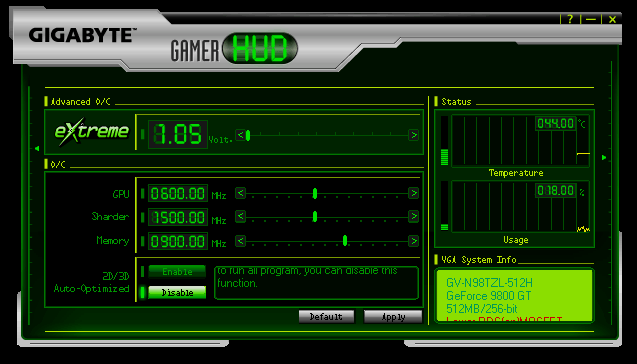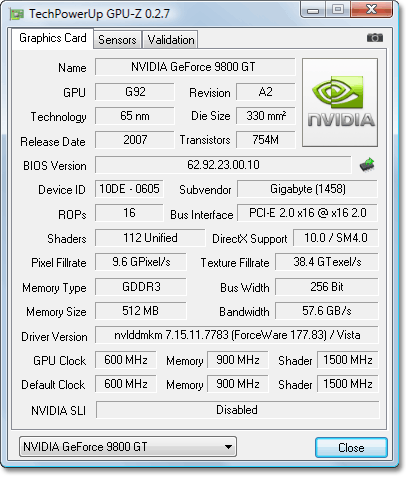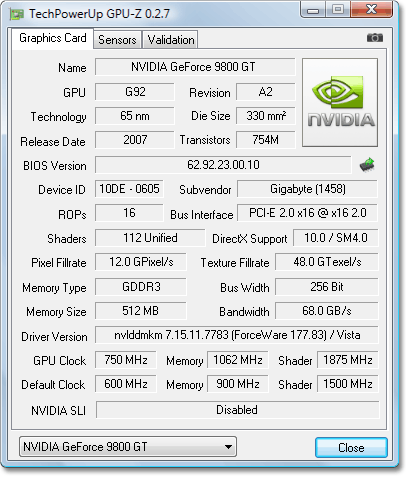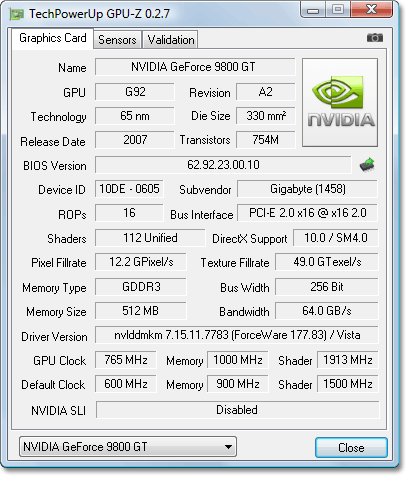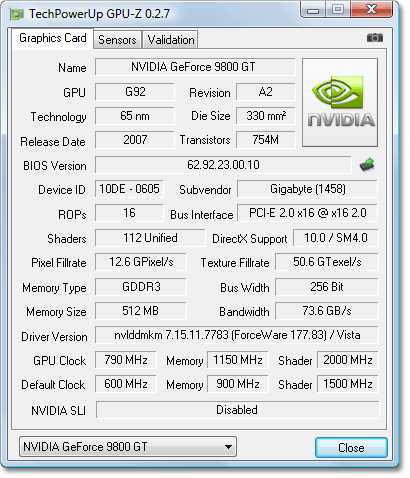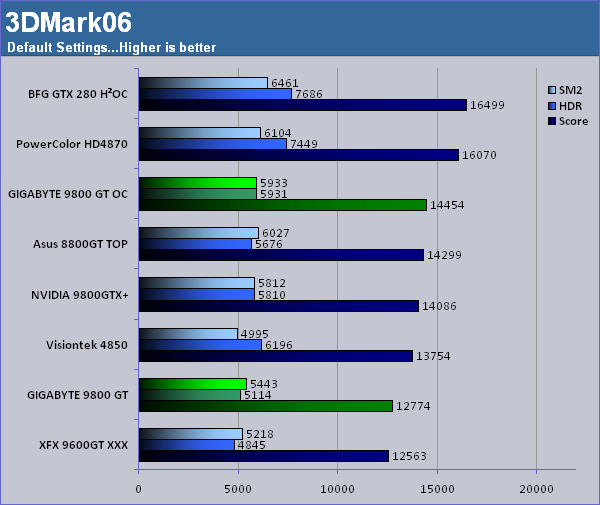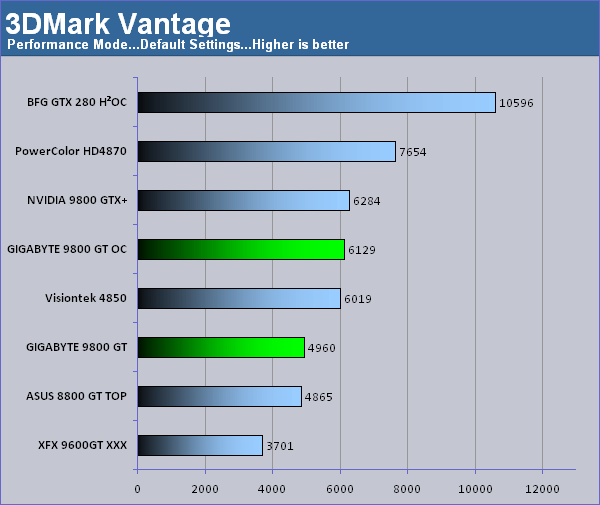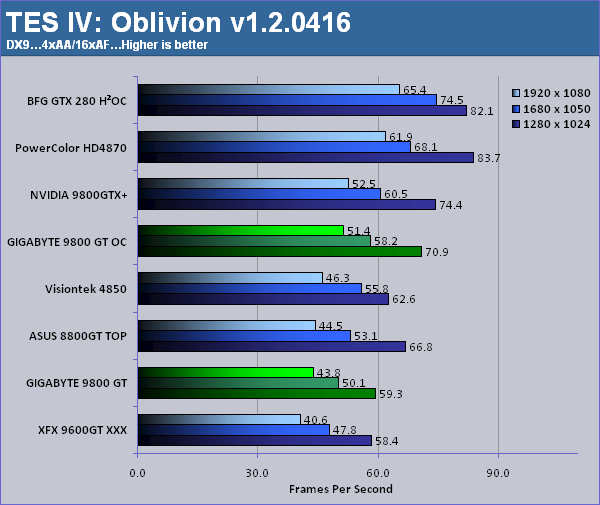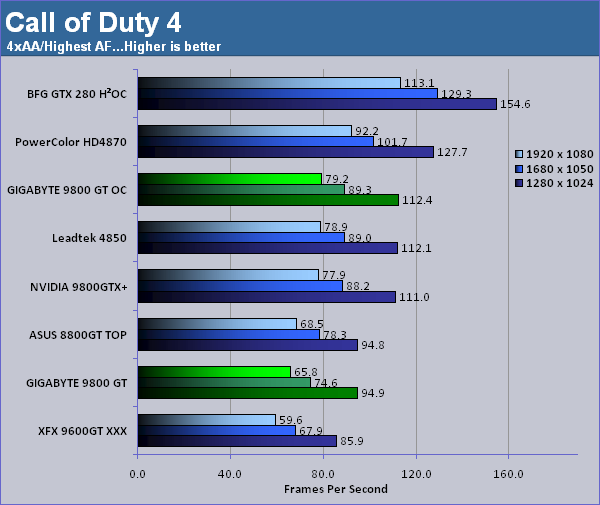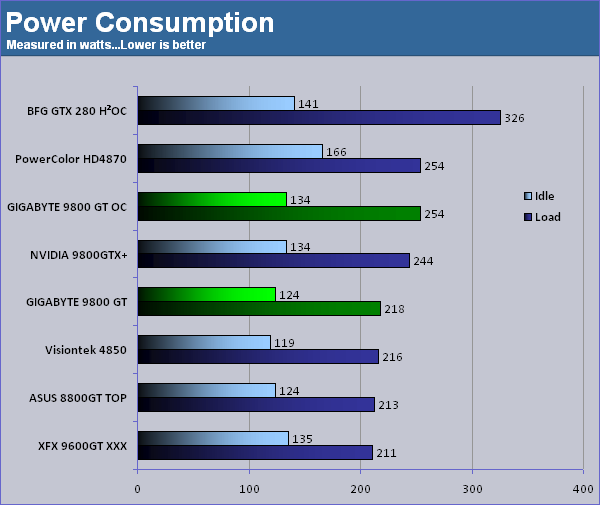GIGABYTE has done it again! With their 9800 GT offering GIGABYTE shows why it has one of the best line up of graphic accelerators in the world. What makes this card so great? Read on to find out!
INTRODUCTION
Today we are looking at the 9800 GT from GIGABYTE. It is a mid-range offering and a re-spin of the wildly popular 8800 GT with Hybrid SLI support thrown in for good measure. We intend to compare this card to its bigger brother the 9800 GTX+ as well as the competition’s HD 4850 and see where we land. For those of you looking to game on a budget I invite you to sit back, relax and enjoy the ride. We have a couple of surprises in store for you today so without any more ado, let’s get to it.
SPECIFICATIONS
| GPU Specifications | ||||
| 9800 GTX | 9800 GT | 8800 GT | ATI 4850 | |
| Fabrication Process | 65nm | 65nm | 65nm | 55nm |
| Transistor Count | 754 Million | 330 Million | 330 Million | 965 Million |
| Core Clock Rate | 675 MHz | 600 MHz | 600 MHz | 625 MHz |
| SP Clock Rate | 1,675 MHz | 1,500 MHz | 1,500 MHz | – |
| Streaming Processors | 128 | 112 | 112 | 800 |
| Memory Clock (Effective) |
1,100 MHz (2,200 MHz) |
900 MHz (1,800 MHz) |
900 MHz (1,800 MHz) |
1000 MHz (2000 MHz) |
| Memory Interface | 256-bit | 256-bit | 256-bit | 256-bit |
| Memory Bandwidth | 70.4 GiB/s | 57.6 GiB/s | 57.6 GiB/s | 64.0 GiB/s |
| Memory Size | 512 MB | 512 MB | 512 MB | 512 MB |
| ROPs | 16 | 16 | 16 | 16 |
| Texture Filtering Units | 64 | 56 | 56 | 40 |
| Texture Filtering Rate | 43.2 GigaTexels/s |
33.6 GigaTexels/s |
33.6 GigaTexels/s |
25.0 GigaTexels/s |
| RAMDACs | 400 MHz | 400 MHz | 400 MHz | 400 MHz |
| Bus Type | PCI-E 2.0 | PCI-E 2.0 | PCI-E 2.0 | PCI-E 2.0 |
| Power Connectors | 2 x 6-pin | 1 x 6-pin | 1 x 6-pin | 1 x 6-pin |
By comparison, the GIGABYTE 9800 GT looks strikingly similar to the 8800 GT from NVIDIA. You could be forgiven for mixing the two cards up and to be honest NVIDIA did not do enough to differentiate the two outside of using a different name. Also, this card does not come with any overclock from GIGABYTE though, as we’ll soon find out this is not a problem.
In its stock form you could expect the 9800 GT to perform identically to its 8800 GT sibling. The 9800 GT does have one trick up its sleeve and it’s a big one. One that is big enough to change the entire game and give the 9800 GT from GIGABYTE a huge kick in the pants. Keep reading to find out what it is.
PACKAGING
GIGABYTE uses a nice color scheme of blue and white on their boxes in addition to their female avatar. Adorning a mix of medieval armor and a futuristic rifle, I can say I have seen much worse when it comes to mascots. The box itself tells you of the two biggest features this card sports; the Zalman heat sink and support for NVIDIA’s Hybrid Power. I, for one, am very pleased to see the hybrid power support though we without the proper motherboard we won’t be testing this feature today.
Click a picture to see a larger view
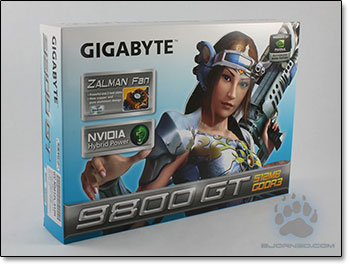 |
 |
| Box front | Box rear |
PHOTOS
The GIGABYTE 9800 GT is a dual slot card thanks to the addition of the Zalman heat sink and fan. Given how hot the G92 core runs this is a welcomed add-on. The only question I have is why leave the memory chips bare? Surely they won’t melt if left at their stock settings though anyone in the market for this kind of card is bound to do some overclocking.
Turning the card around to its rear we see the 6-pin power plug and the high-quality solid capacitors and mosfets. These serve to provide cleaner, more stable power to the card which results in less cooling required as we’ll see in just a bit. GIGABYTE also stick to their blue PCB which I like over the boring green PCB of other manufacturers. Let’s just hope we don’t arrive at a point one day where enthusiasts are trying to color match they video cards to their motherboards.
Our next two pictures show off the clean design of the board overall. By using higher quality components GIGABYTE is able to make a board that is simpler to manufacture and easier to cool.
Click a picture to see a larger view
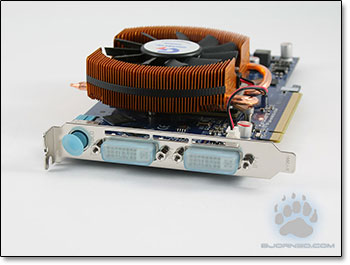 |
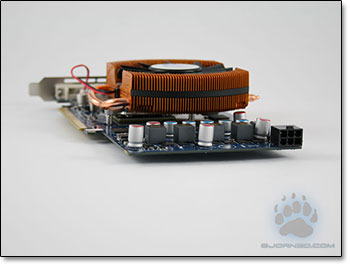 |
 |
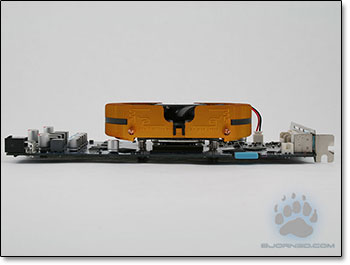 |
Our last two images show us the meat and potatoes of the card, the core and memory modules. The core as you may or may not know is the G92 core or to be more specific, the G92-270-A2 revision. Anyone looking for a new core or maybe a 55nm version of the core will be disappointed. Though not for long when we get to the performance section.
The memory modules used are the Samsung k4j52324qe-bj1a which, after a quick trip to the Samsung website, are rated for up to 1000 MHz operation with a VDDQ of 1.9v +/- 0.1v. basically this means we are given 100 MHz of free speed on these bad boys and maybe a bit more. Things are looking very promising!
Click a picture to see a larger view
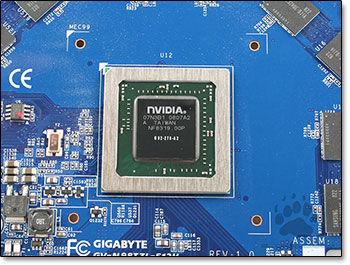 |
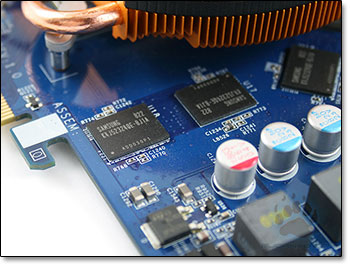 |
CONTENTS
The GIGABYTE 9800 GT comes with a basic assortment of accessories. In an effort to keep costs down, this also means that there is no game included which is a bit disappointing but certainly not a show stopper. GIGABYTE offers the following accessories with their card:
- Driver CD
- User Manual
- DVI-VGA adapter
TEST SETUP
All tests were conducted on the following platforms. A format of the hard drives followed by a fresh install of the OS was done. The latest drivers were then installed and all non-essential applications were halted.
| Test Platform | |
| Processor | Intel QX9650 @ 3.5GHz |
| Motherboard | XFX 790i Ultra |
| Memory | 2 GB (2 x 1 GB) Mushkin DDR3-2000 |
| Drive(s) | 1 – Seagate 80GB Barracuda SATA 1 – Samsung HD501LJ SATA |
| Graphics | Card 1 – GIGABYTE 9800 GT Card 2 – PowerColor HD 4870 Card 3 – BFG GTX 280 H²OC Card 4 – Visiontek HD4850 Card 5 – ASUS 8800GT TOP Card 6 – NVIDIA 9800 GTX+ Card 7 – XFX 9600 GT XXX |
| Drivers | Forceware 177.83 – 8800 GT, 9600 GT, 9800 GT, 9800 GTX+, GTX 280 Catalyst 8.7 – HD 4850 , HD 4870 |
| Sound | On board |
| Cooling | Big Typhoon VX |
| Power Supply | OCZ GameXStream 850 watts |
| Display | Westinghouse 37″ LVM-37W3 |
| Case | No case |
| OS | Windows Vista Ultimate 32-bit SP-1 |
All cards will be tested using a variety of games. For Crysis, we will be testing the game both without any image enhancements and then again with 2x Anti-Aliasing and 8x Anisotropic Filtering. All other games will be tested with 4x AA and 16x AF. The resolutions tested are 1280×1024, 1680×1050 and finally 1920×1080.
OVERCLOCKING
To help with overclocking your card GIGABYTE includes a very special piece of software called GamerHUD. This is GIGABYTE’s overclocking tool and it can do more than just change some frequencies. It can adjust voltage! No longer is your card held back by the confines of too little voltage. Now with the help of GIGABYTE you can coarse 1.4 volts of high octane juice through this beast and it makes for some awesome overclocking.
To be a little more specific, with GamerHUD you can change the core, shader and memory frequencies of the card and you have the ability to adjust the voltage of the core only from 1.05v all the way up to a core melting 1.4v. The stock voltage is 1.15v so for those looking to save some juice you can dial this down and save some electricity.
Enough about the software let’s see just what this card can do!
First we look at the card under its default settings.
Stock
Next, we left the voltage settings alone and in small increments we dialed up the core speed. Once we started to see artifacts in ATiTOOL we would lower our frequencies until we could scan for fifteen minutes without any issues. After that we returned the core back to default and did the same for the memory modules. Once we had our relative maximum speeds we combined the two, tweaking as we went along, until we came upon our overall highest overclock that is stable. Just what was our maximum stable overclock on default voltage?
Overclocked (Stock Voltage)
An awesome 750 MHz core speed combined with 1,875 MHz shader frequency and 1,062 MHz (2,124 MHz effective) memory speed. All this done on stock voltage! Truly impressive.
Next up we upped the voltage straight to the maximum setting allowed of 1.4v and followed our same procedure.
Overclocked (1.25-1.4 Voltage)
The overclock increase from added voltage was disappointing though something didn’t seem right. I lowered the voltage all the way down to 1.25 and this overclock held strong so I knew it wasn’t a matter of not enough power. Also, the memory frequency needed to be lowered due to an increase in artifacts. Keeping an eye on the temperature of the core I noticed as soon as it hit 68º C artifacts popped up. That’s it! It wasn’t a power problem, it was a heat problem. Well, I wasn’t about to let this get it my way. Grabbing the beefiest VGA cooler I had in my arsenal I was determined to find this cards limits.
The cooler of choice was none other than the versatile Thermalright HR-03 GT. It was a straight swap thanks to the same mounting holes used by the 8800 GT. Now with better cooling on the core and heat sinks taking care of the memory modules it was time to get serious.
I upped the voltage back to 1.4v and this is what I landed at thirty minutes of testing later.
Overclocked (1.4 Voltage)
At this point the card could go no further but I was more than satisfied. The memory which was previously left bare had shown amazing performance gains with some heat management. The core and shader speeds also improved even further with better cooling and the temperatures were even lower than before. Truly GIGABYTE has a great card on their hands even for people who choose to keep the stock cooling solution and an even better one for the more adventurous types.
We are almost ready to begin our testing process but before we do I wanted to inform you that we would test this card a bit differently. Rather than just test the card in its stock form, we are going to test the card at its overclocked speeds reached with stock volts. This overclock is well within anyone’s reach and since it is such a huge improvement over stock it will be interesting to see what gains are to be had from it. To recap, the overclock speeds are Core-750 MHz, Shader-1875MHz, and RAM-1062MHz.
Let’s see what this puppy can do!
TEST RESULTS
An old favorite of benchmarkers. 3DMark 2006 is a fun tool to have if you want to brag to your friends but when it comes to representing real world performance it falls far short of the mark. We include the scores here only to be thorough.
The newest video benchmark from the gang at Futuremark. This utility is still a synthetic benchmark but one that more closely reflects real world gaming performance. While it is not a perfect replacement for actual game benchmarks it has its uses. We test our cards at the ‘Performance’ setting as this will be the most widely used setting.
Currently there is a lot of controversy surrounding NVIDIA’s use of a PhysX driver for its 9800 GTX and GTX 200 series cards. Whereby installing the PyhsX driver, 3DMark Vantage uses the GPU to perform PhysX calculations during a CPU test and this is where things get a bit gray. If you look at the Driver Approval Policy for 3DMark Vantage it states
Based on the specification and design of the CPU tests, GPU make, type or driver version may not have a significant effect on the results of either of the CPU tests as indicated in Section 7.3 of the 3DMark Vantage specification and white paper.
Did NVIDIA cheat by having the GPU handle the PhysX calculations or are they perfectly within their right since they own Ageia and all their IP? I think this point will quickly become moot once Futuremark releases an update to the test. For now we will show ONLY the GPU score since this is much less influenced by the inclusion of PhysX.
Synthetic testing is fun and shows us about what we expected when it comes to performance of the 9800 GT. Now let’s get to the heart of any good video card review, the games!
We test Oblivion by using a manual run through and record our performance using FRAPS. I start outside the town of Cheydinhal on horse back and taking the same route each time, I travel to the Imperial City. The trip takes a full six minutes and encompass’ long view distances, water, forests, Oblivion gates and NPC’s. Being such a long trip, any changes from one run to the next (e.g. a wandering NPC) would have an effect equal to less than 1% on frame rate. This method gives me great insight into the real world performance of each card tested.
All settings are maxed out and we use bloom lighting for our tests.
At its stock speed, the GIGABYTE 9800 GT doesn’t perform all that impressively. Once you turn up the settings though, watch out! The 9800 GT is almost able to match the performance of the more expensive 9800GTX+ which is no easy feat. Even beating out the HD4850 is worth a lot of credit. Let’s see if this is the start of a trend or just an anomaly.
DirectX 9
For these tests of CoH, we ran the game using the DirectX 9 path with the maximum in-game settings applied. Both minimum and average scores are shown.
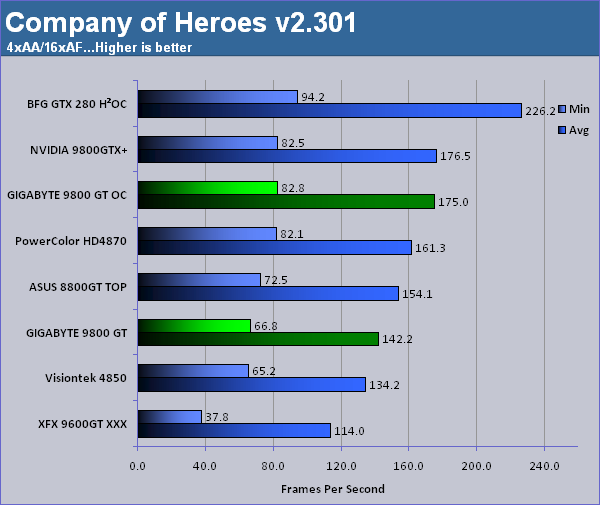

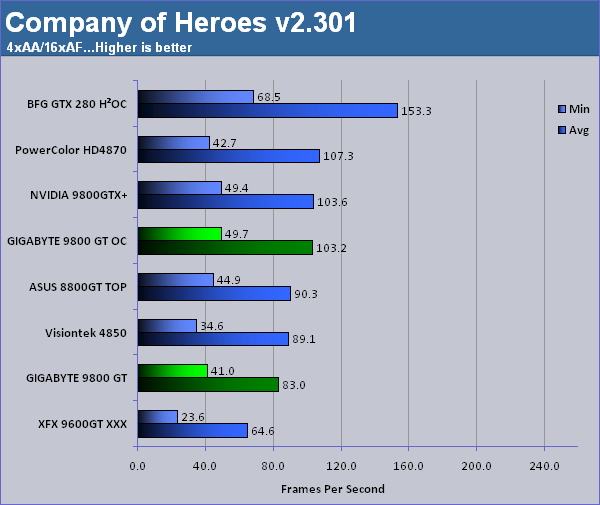
Wow! Again, we see that at its stock speed the 9800 GT provides a playable experience though not nearly as much as the other cards. The secret lies in that amazing overclock. Remember that this is also not the card’s maximum overclock since that took the use of a different cooler. It is amazing to see this card hot on the heels of the HD 4870 and 9800 GTX+ .
Let’s see how the card handles some DX 10 action.
DirectX 10
Even though we are running this game with DirectX 10 all in-game settings have been kept the same. CoH, when run with DirectX 10, enables a higher setting for textures labeled as ‘Ultra’. We did not enable any extra features so that the only difference between the tests is which DirectX version was used. This enables us to compare the two if we wanted to see any performance gain/loss between the two render paths.
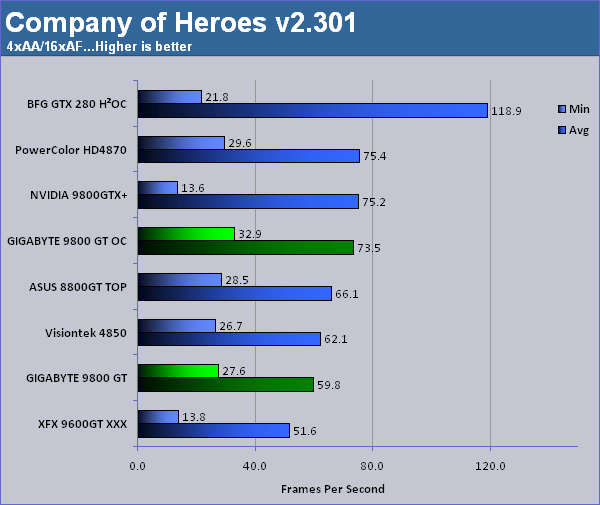
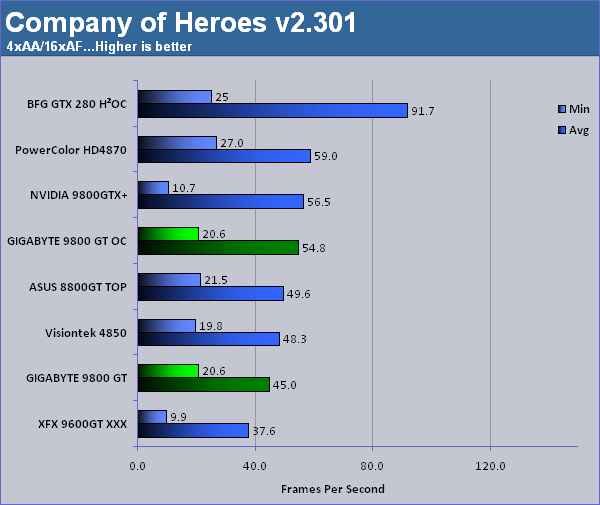
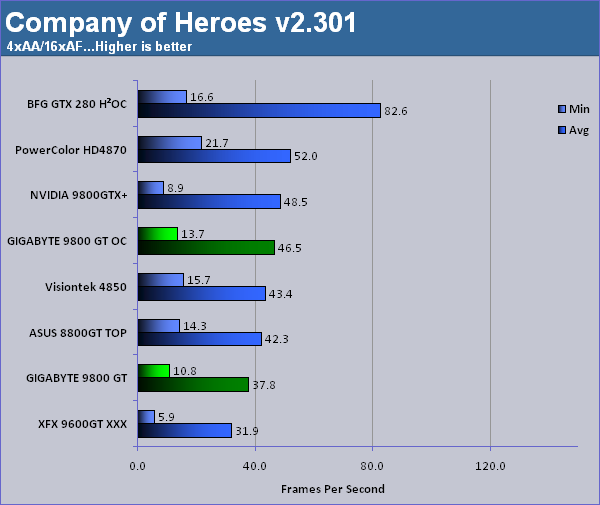
Once again we see the GIGABYTE 9800GT vault over the competition and start knocking on the door of the bigger (and more expensive) 9800 GTX+ and HD 4870.
DirectX 9
For World in Conflict we set everything to their maximum allowed under DirectX 9.
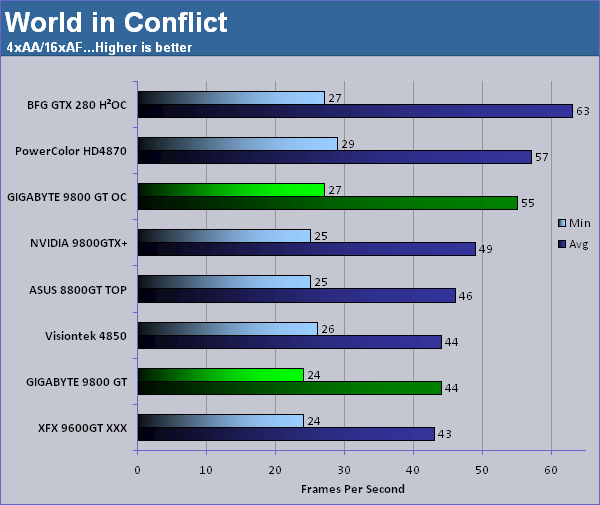
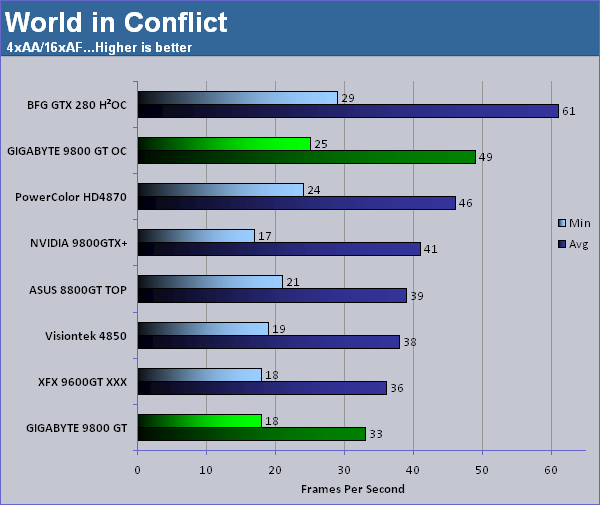

As if the previous two benchmarks weren’t enough we now see the GIGABYTE 9800 GT take over second place! The only card tested that is faster is the significantly more expensive GTX 280. The 9800 GT is akin to Dr. Jekyll and Mr. Hyde. By day the card is a simple, efficient tool for some light gaming but by night this thing becomes a monster that feeds on graphics and spits out frames by the boat load.
DirectX 10
For World in Conflict we would do things a bit differently. This time for DX 10 we enabled the only extra setting that is available by using DirectX 10, Volumetric Light (aka God Rays).
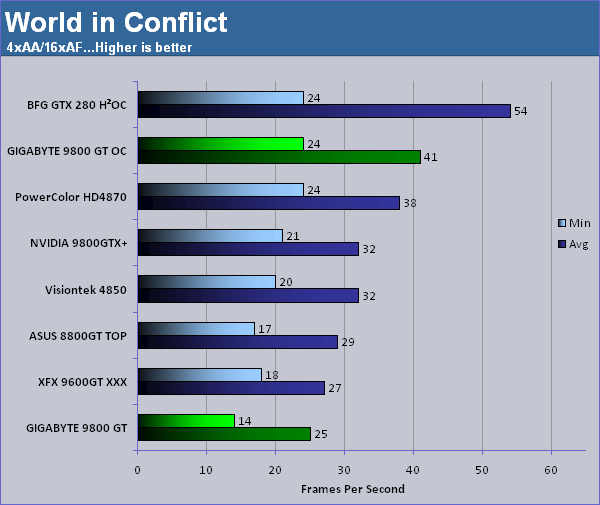
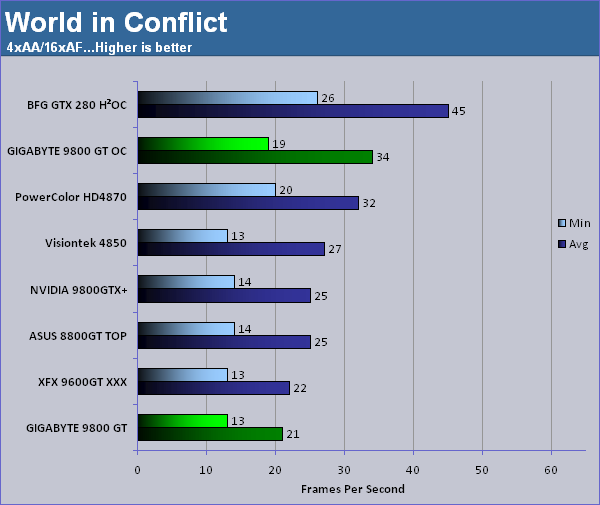
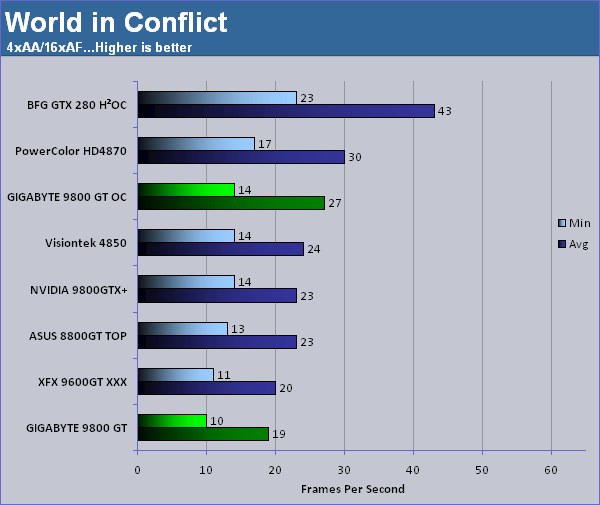
The trend continues on the DirectX 10 side of the fence. Only at the maximum resolution tested do we see the 9800 GT give way to the bigger HD 4870. It is hard not to fall in love with a card that is capable of so much all the while not chewing up your electricity.
Similar to CoH, Crysis is run in DX 9 mode. All settings were set to HIGH and we ran the game first without any AA/AF and then again using 2xAA and 8xAF. Results shown are the average frames per second.
DirectX 9
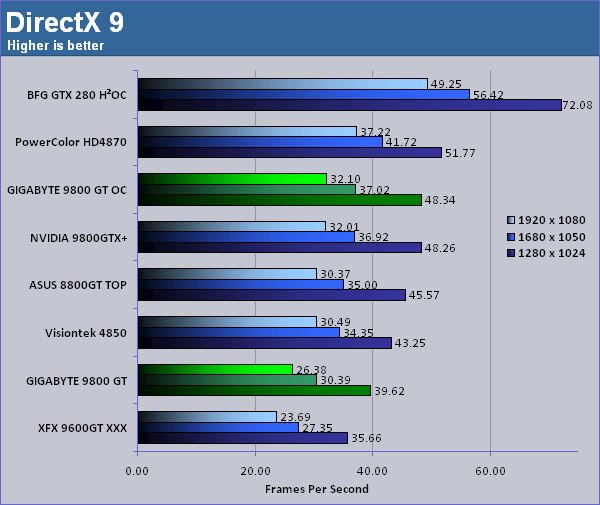
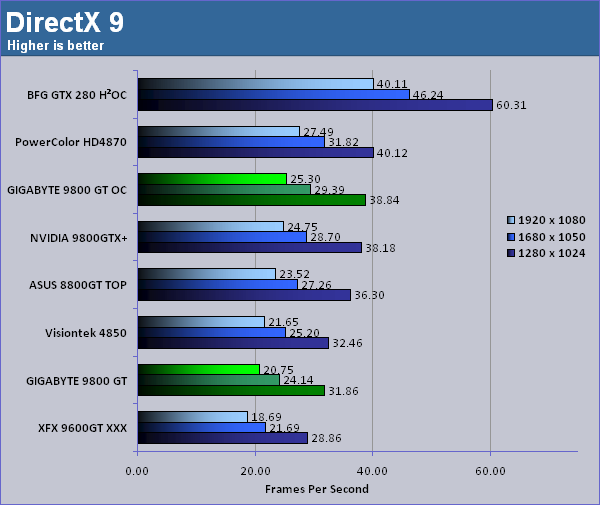
The 9800 GT continues to impress. At its stock speed the card is pretty unremarkable, offering performance on par with the far cheaper 9600 GT. But once overclocked, it becomes a different card altogether, offering playable frame rates in Crysis even with AA enabled.
DirectX 10
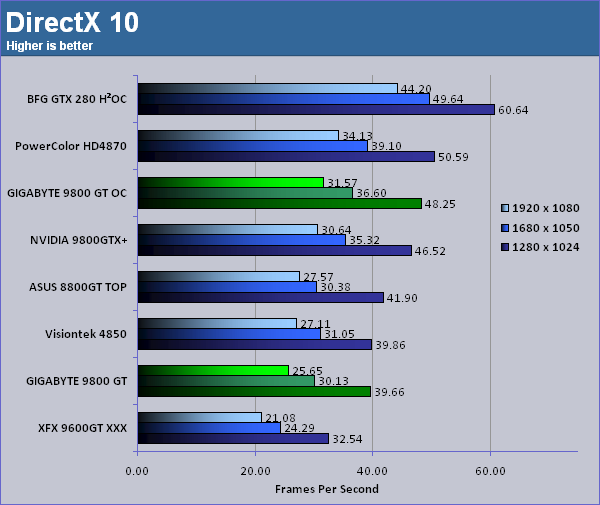
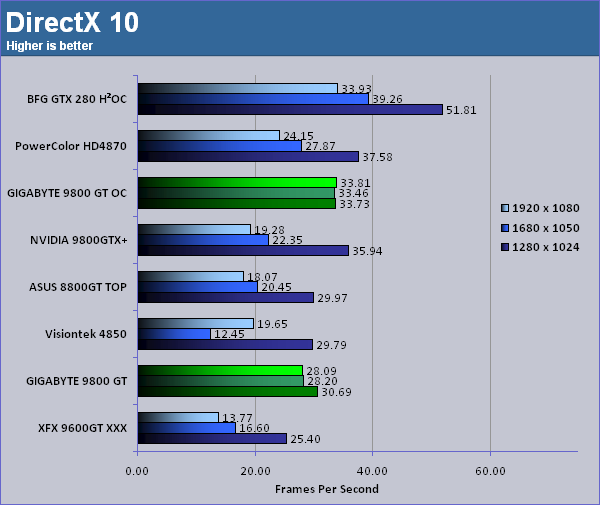
Here we see what can only be described as a driver issue. As much as I would love to see a $200 card offering better performance than a $400 card it simply isn’t happening. Not here anyway. I tested and retested this game but it seems that it doesn’t play nice with Crysis under DirectX 10 when AA is turned on. Oh well, we can dream can’t we.
Call of Duty is played with all settings placed at their maximum level. AA is set to 4x and Anisotropic filtering is set to max.
It seems even the Unreal 3 engine loves some fast clocks and the 9800 GT is more than happy to oblige. This is one game where even at its stock settings the 9800 GT offers a great experience with a FPS of 65 at our highest tested resolution. Once overclocked, we enjoy a nice 13-15% increase in performance which comes in handy for those with 30″ displays who ran out of money for a video card.
TEST RESULTS
Here is where we separate the men from the boys. Sure you’ve seen all the great performance this card has to offer but at what cost does it come? Will you need to refinance that home of yours to keep gaming for a few more months or will solar power be enough to keep you in the game. Power levels shown below are for the entire system sans monitor.
- CPU: QX9650 @ 3.5 GHz 1.35v
- MOBO: XFX 790i Ultra
- RAM:2 GB (2x1GB) DDR3-2000 1.9v
One place I am happy to see the GIGABYTE 9800 GT finish towards the bottom of the pack is in our power consumption tests. I also tried lowering the voltage of the card to the minimum allowed (1.05v) by the GamerHUD software but did not observe any difference in power consumption.
Idle temps were taken after a 15 minute period of sitting at the desktop with no open windows. Load temps were recorded by using ATiTool 3D view to place a constant load on the card.
| Temperature | ||
| Idle | Load | |
| Stock | 43º C | 61º C |
| O.C. | 44º C | 66º C |
Our temperature tests show the increased clock speeds result in higher temps. No real surprise there but as stated before this card has a hard limit of 67º C. Once passed artifacts immediately appear. Thankfully this card is easy to keep cool with its stock Zalman cooler. For those looking to push this card to the max, be aware that you will need a better cooler to get the job done.
CONCLUSION
Simply amazing! For those who jumped right to the conlusion I seriously suggest you look at the performance this card can muster. It is almost like we are dealign with two different cards, the stock card and the overclocked card. For anyone who may purchase this card and not overclock this card (I hear these people actually exist) you will find yourself with a very power friendly card that performs admirably at resolutions of 1680×1050 and under. The real treat comes when you start cranking up those clock speeds. Being able to meet and in some cases beat the performance of the HD 4870 is no easy feat for a mid-range card and even more amazing when you factor in the price.
At time of publication you can pick up the GIGABYTE 9800 GT for $149.99 after a $20 mail in rebate. The cheapest HD 4870 found goes for $260 with no rebates. That amounts to a savings of $110 dollars with almost identical performance. I think the numbers speak for themselves.
The only downside really is the lack of a game and no pre-overclock on the card. Just imagine how many of these cards GIGABYTE would sell if they overclocked them similarly to what we achieved here and sold them at the same or very close to the current price. You would have a serious HD 4870 killer on your hands.
FINAL WORDS
Performance: 8.5/10 – This card receives an 8.5 for the fact that its stock performance is rather mundane. It would have received a lower score if not for the amazing performance gains to be had from some simple overclocking. To match the performance of cards that are more than 50% more expensive is a sweet deal if I ever saw one.
Bundle: 7.0/10 – Perhaps GIGABYTE has spoiled me with their great bundles in the past. I found the lack of a game to be disappointing and the bundle as a whole is rather meager.
Value: 10.0/10 – The performance per dollar this card offers is unrivaled at this time. For $150 USD you can have the performance of cards much more expensive with a little bit of overclocking. Throw in a more heavy duty cooler and some ram sinks and you have some serious overclocking head room.
Pros:
+ Exceptional performance for the price
+ Supports Folding@Home
+ Dual slot cooler is quiet
+ Amazing overclocking with stock voltage
+ Low cost of ownership
Cons:
– Lack of game or software in bundle
The 9800 GT from GIGABYTE scores an 8.5 out of 10 and receives the Bjorn3D seal of Approval
 Bjorn3D.com Bjorn3d.com – Satisfying Your Daily Tech Cravings Since 1996
Bjorn3D.com Bjorn3d.com – Satisfying Your Daily Tech Cravings Since 1996

